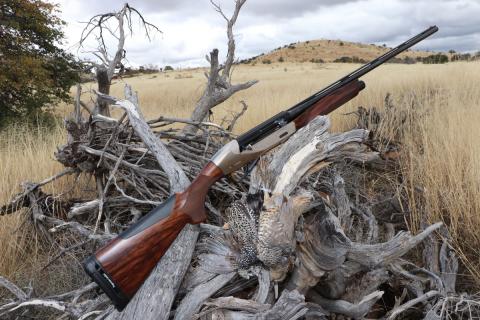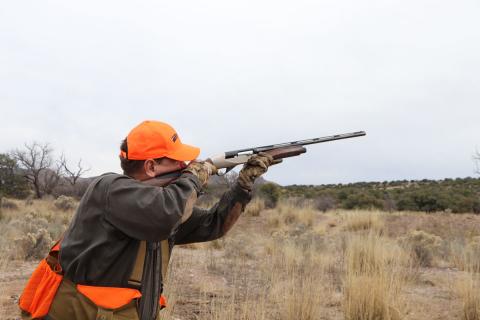Quest For Desert Quail
Editor's Note: This is one of a series of bird-hunting articles in conjunction with SCI’s new Birds of the World program.
As the quail started to gain altitude behind him, Zent pirouetted in-place, the Benelli 28-gauge going instinctively to his shoulder as he completed the turn and put the bead on the bird….
Nature is wondrous. Hunters drink deeply from the cup of life. Others merely observe nature. Hunters are part of it.
Quail hunting, depending on where and for what species, is a world unto itself in that the small, fast upland birds traditionally have captured the imaginations of young and old, rich and poor. For all, it is pure sport that delivers some of the best table fare imaginable.
The focus of this bird safari was on the three types of quail that can be hunted in extreme southeastern part of the Arizona: Gambel’s, scaled (blue) and Mearns’ (Montezuma). It is in an area where all three occur, sometimes on the same hillsides and in the same canyons. We took all three in a single day.
Hidden up a canyon in the rolling foothills of the Chiricahua Mountains, not far north of Mexico in Cochise County is the lodge of El Coronado Ranch. It and other neighboring ranches form a patchwork of private holdings around the Coronado National Forest.
This is still very much the Wild West in many ways. These vast open spaces are where truly wild gamebirds are hunted on foot behind pointers that course through the arroyos and across the rolling hills, locking-up when they nose the scent of quail hiding among the scattered ankle-turning rocks hidden just out of view in the tall grasses that bend gracefully in the breeze.
Because hunting there at 4,600 to 6,600 feet elevation involved six to 10 miles of walking a day, it also was a perfect place to check out the svelte and lively 28-gauge Benelli Ethos semi-auto shotgun. The 28-gauge version completes the line that also includes 12 and 20-gauge guns.
Scribes Anthony Licata of Outdoor Life/Field & Stream Magazines, Steve Gash of Gun Dog Magazine, John Zent of American Hunter/American Rifleman Magazines and the author joined Tim Joseph and Josh Ward, who represented Benelli. Also helping the effort were Federal Premium Ammunition, Filson vests, Irish Setter boots and Yeti coolers. Dave Brown Outfitters provided the guides and dogs.
Western quail hunts differ significantly from those to the east in two significant ways: the birds themselves and the cover/terrain in which they live.
Bobwhite hunts in the South with mule-drawn wagons, thick cover and tall trees draped in moss can be as genteel as they are sporting. Quailing in the West is more like big game hunting for little birds with scatterguns.
Each of the three types of quail on this hunt has its own characteristics and presents different kinds of challenges for both dog and man.
The most common of the three in Arizona is the Gambel’s. It behaves quite similarly to the valley quail of California. They even look pretty much alike, with their distinctive feather topknot jutting upward from the crown of their heads.
Of the three types, Gambel’s can be considered more of a general hunting bird in that they do the same kinds of things other quail do, but they do the various things rather equally.
By comparison, scaled quail are more apt to run farther more often and wild flush farther away, while Mearns’ are more likely to sit tightly.
Over the years, I have come to consider the Gambel’s more of a “hunter’s bird,” the scaled more of a “shooter’s bird” and the Mearns’ more of an “athlete’s bird” because of high elevation and often steep country it calls home (once hunters are onto the Mearns’, the birds tend to sit so tightly that it is easy to pass them by or almost step on them before they flush). Because of where they live and other characteristics, hunting of the Mearns’ is more like the hunting for California mountain quail than for any of the other types of quail.
This hunt reminded me of a marathon quail adventure decades ago when I did a quail slam, all during a long three-day weekend.
It started in California during the latter part of the season when seasonal snows pushed the mountain quail down to lower elevations, where they were mixed in one area with year-round resident valley quail.
On a quick outing the first day, I bagged both types of quail in the Golden State and hit the road for Tucson, where I took some Gambel’s before heading southeasterly to bag scales. Then I hit the high country, where Mearns’ went to bag.
An overnight trek along the Interstate put me in Texas, where bobwhites were bagged – and then it was a very long drive back to California. Although I have taken both Gambel’s and scales in the intervening years, this trip was the first time I bagged any Mearns’ since that long foray years ago. Felt good. Regardless what other kinds of quail a hunter pursues, Mearns’ are a whole new game.
It also was nice to be in the field again with old huntin’ buddies. For example, Licata and I shared a hunt some time back, which, if I remember correctly, was a combo deer and duck expedition; and I have been on bird bonanzas with both Joseph and Ward. Gash is now a new huntin’ buddy – hadn’t had the pleasure of hunting with him before.
Zent and I have crossed paths in all manner of settings over the years. He is a hardcore hunter in the purest sense of the term. He and I were paired in the 2×1 quail hunting program with guide James Thornburg and his dogs.
Of all the birds we both bagged, one stands out vividly. The two dogs had been acting birdy as we crested a grass-covered gentle hill, when one locked on point and the other quickly honored. I covered Zent’s right flank.
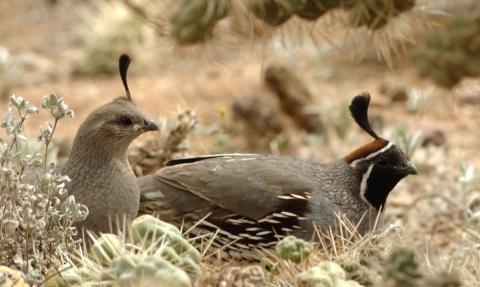
Zent moved in, but instead of flushing forward or to the side, the Mearns’ flushed a foot or so from Zent’s foot, flying almost what looked like through his legs (beside actually), and then hit the throttle, zipping away directly behind him.
At that point, the scene was hunter’s dream, seemingly in slow motion. As the quail started to gain altitude behind him, Zent pirouetted in-place, the Benelli 28-gauge going instinctively to his shoulder as he completed the turn and put the bead on the bird. A quick shot, and the quail folded, dropping in an arc to the ground. It was so quick, so smooth, so beautiful and so rewarding to watch. Golden moments like that can make an entire hunt worthwhile.
A bonus for me was to be able to take all three types of quail available with three different gauges of gun. On the hunt, Benelli provided their Ethos model semi-auto in 12, 20 and 28-gauge.
Each weighs and handles differently. All are effective, which means that it is a personal matter as to which size is preferred.
Overall, the 20-gauge Ethos makes sense for birding for most species most places in the world. Previously, I had the opportunity to hunt both waterfowl and doves with the 20-gauge Ethos. See SAFARI May/June issue (insert url/square code).
However, in some places around the globe, ammunition available is less than the best, which can make the 12-gauge the logical choice for bird hunts in those places. When premium ammo is available, a 20-gauge can handle just about any kind of bird hunting.
The 12-gauge has more girth and weight than the 20, but carries and handles quite smoothly and effectively. And, the 28-gauge is akin to a wand that responds in the field like a nimble sportscar on a gymkhana course.
Strictly for hunting quail, the 28-gauge makes the most sense, especially when the hunt calls for multiple miles at higher altitudes over challenging terrain.
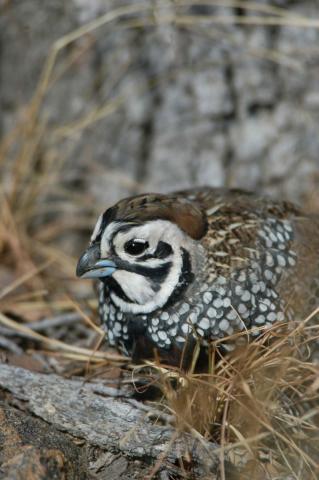
For traveling international bird hunters, it makes sense to have all three sizes handy so that the optimal size/performance parameters for each specific hunt can be realized, enhancing success.
Hunting with good guns behind good dogs for truly wild birds is a fulfilling experience known only to those who do it.
This is why hunting is so much more than bag count for birds or antler measurement for deer. It is the entire experience that makes hunting the human imperative that it is now and always has been.
We hunt because that’s what hunters do and have done since the beginning of our species as part of the natural order. On each hunt, regardless the location in the world, hunters learn about that area, the people and wildlife there and what makes them special.
When this can be done in a congenial setting among fellow hunters, the experience becomes complete, rewarding and memorable for a lifetime.
Each evening, we dined deliciously in the expansive opulence of the lodge at El Coronado. Whether in such a refined setting, or just sitting around a campfire, day’s end on hunts sees those participating sharing experiences of the day and of their individual lives. It is a sense of community not known in the rest of society.
On this particular hunt, there was an added, unexpected element that put the complete experience over the top. Ranch owner Valer Clark graciously joined us in the evenings at the lodge and opened a discussion that involved new-to-us elements of land and wildlife conservation.
Valer, formerly of New York (Manhatten to be precise), has spent decades rehabilitating the landscape on El Coronado, as well as on another expansive ranch just south of the border in Mexico. The result is the best quail habitat in the State of Arizona and a whole lot more.
Quail have not been the only wildlife to benefit from her tremendous efforts. Deer, bears, mountain lions, wild turkeys and all other manner of wildlife live there in abundance. It all boils down to water. When water is present in the desert, both the land itself and anything living on it benefit.
Literally, she has turned landscapes that looked like the surface of the moon into slices of Eden.
Central to her efforts are gabions, mechanisms that slow the downward flow of water, allowing it to soak in and stay in the immediate area rather than racing all the way to the next zip code and beyond.
The whole idea, Valer explained, is to harvest what natural waterfall comes to the area and, in doing so, to help nature heal wounds from both human and natural negative influences.
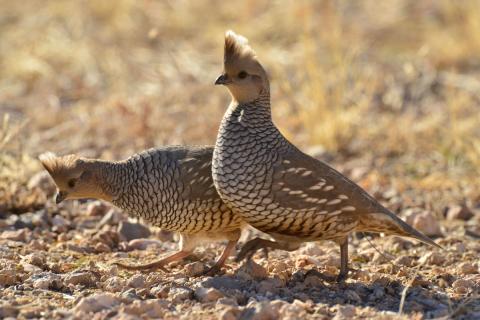
Valer’s gabions essentially are small rock dams in the watershed that includes natural ditches and arroyos. They are constructed in series from higher-up, downstream. The top of each succeeding gabion downhill is the same height as the bottom of the gabion above.
Over the years, Valer and her ranch hands have constructed thousands of these small hydro-flow inhibitors and the result is lush greenness where bare rock and eroded coarse sandy soil used to be.
Concurrently, she has, to the extent possible, replaced invasive grass species with types that have occurred there naturally forever. The overall result has been a recreation of what existed in the area before outside influences changed things.
That is why this area is such a good place for all three types of desert quail. They are natural parts of these surroundings. Yes, there is something special about hunting wild birds in wild places.–Steve Comus


